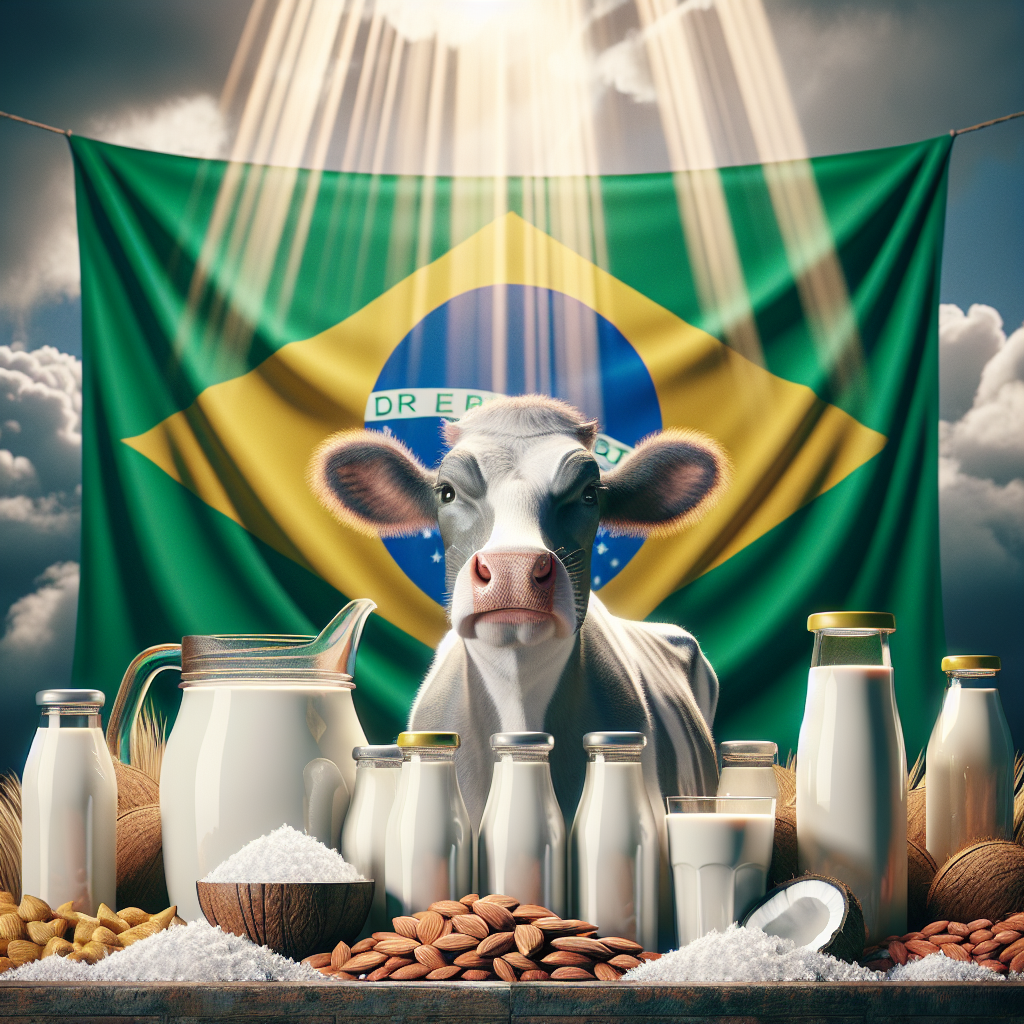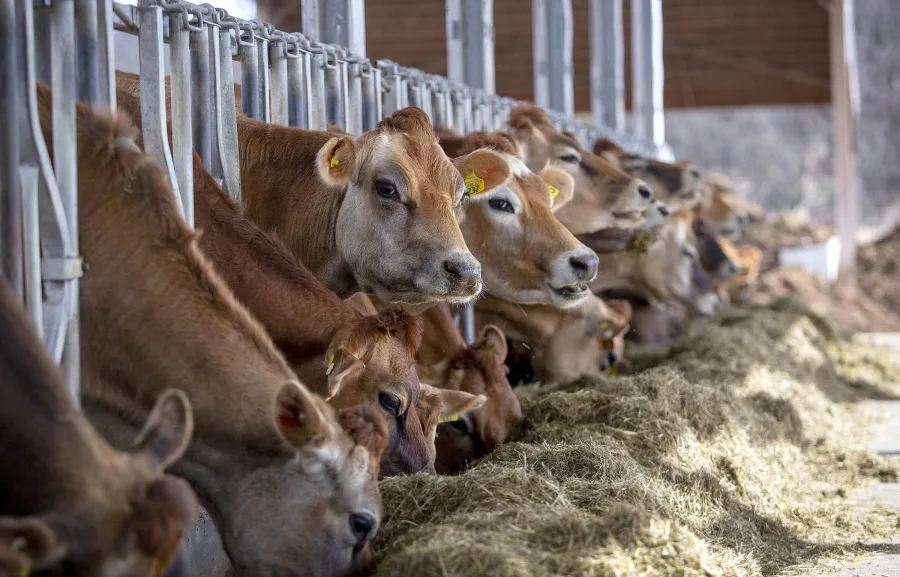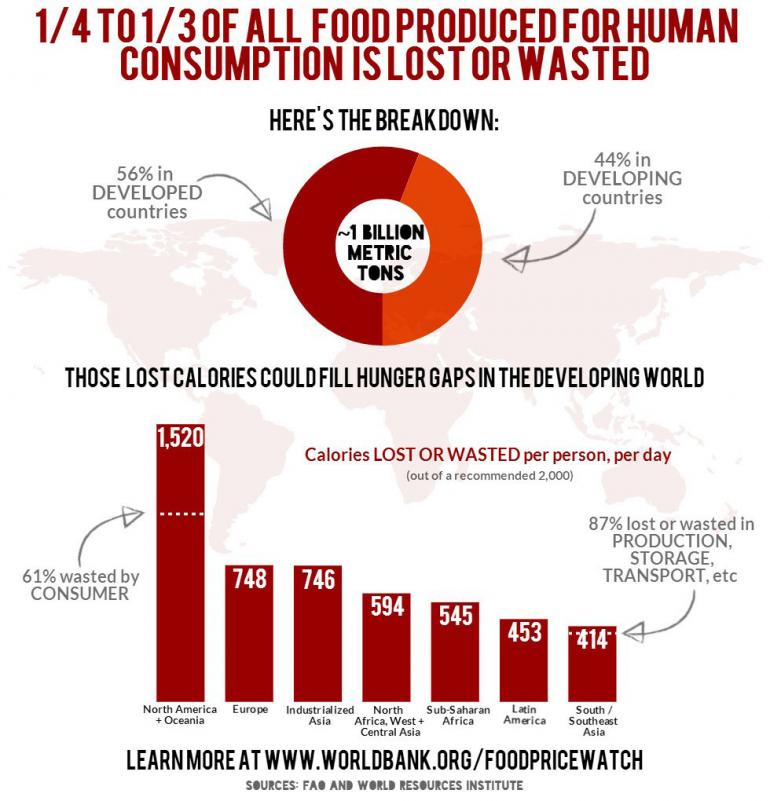Can Brazil’s dairy industry survive the Green Revolution? Explore the challenges and opportunities as alternative proteins reshape the market.
Summary: Brazil’s bold move with Bill 3357/2024, championed by Congressman Jorge Goetten and supported by the Good Food Institute, aims to revolutionize the food industry by introducing and regulating cell-cultured foods, potentially making the country a global leader in alternative proteins. This shift promises sustainability and affordability but poses significant challenges to the traditional dairy sector, already burdened by high costs and increased imports. With cell-cultured foods requiring up to 99% less land, 96% fewer greenhouse gas emissions, and 82% less water, local dairy farmers face new competition that could further strain their livelihoods, raising important questions about the future of Brazilian dairy and food sovereignty.
- The introduction of Bill 3357/2024 aims to position Brazil as a leader in the alternative protein market.
- This could threaten the Brazilian dairy industry, which is already facing high production costs and competition from imports.
- The bill is backed by the Good Food Institute and other global market players, suggesting strong support for the initiative.
- Dairy farmers may need to adopt new technologies and sustainable practices to stay competitive.
- The rise of alternative proteins presents both a challenge and an opportunity for the Brazilian dairy sector.
- Increased funding and tax incentives could shift focus and resources towards the alternative protein industry.
- Local dairy production must innovate to reduce costs and improve sustainability to compete in a changing market.
- The future of the dairy industry in Brazil will depend on its ability to adapt and evolve alongside emerging food technologies.

Is a significant disruption about to occur in Brazil’s dairy industry? The country’s food production landscape may radically change due to the recent introduction of Bill 3357/2024, which aims to regulate the production and sale of cell-cultured foods. This law, sponsored by Congressman Jorge Goetten and backed by groups like the Good Food Institute (GFI), is expected to push Brazil to the forefront of the market for alternative proteins. Gabriela Garcia of GFI states, “The initiative seeks to encourage the development of meat and other food products without relying on livestock, using fewer resources, and generating a reduced environmental impact.” Although the law creates new opportunities for sustainability and innovation, the dairy industry—struggling with rising production costs and increased imports from Uruguay and Argentina—has severe worries about it. Is this the last straw that breaks an already fragile industry?
The ‘Green Revolution’ in Brazil: A Bold Leap Towards a Promising Future in Sustainable AgricultureDriven by technological developments and creativity, Brazil’s “Green Revolution” signifies a revolutionary change toward sustainable agriculture and food production. Cell-cultured foods are developing; it’s a revolutionary way to produce dairy, meat, and other food items without conventional animal farming practices.
Cell-cultured meats, sometimes called lab-grown or cultured meat, are produced by growing animal cells in a sterile environment to resemble traditional beef in flavor and texture. This strategy might completely transform the food sector since it offers many advantages.
To begin with, foods grown in cells have the potential to lessen the environmental impact of food production drastically. Research by Bryant and Barnett (2020) found that compared to traditional animal farming, the production of lab-grown meat requires up to 99% less land and produces up to 96% less greenhouse gas emissions. These numbers demonstrate how crops cultivated in cells may help solve the urgent problem of climate change.
Furthermore, producing meat from lab-grown animals uses minimal resources. Wilks and Phillips (2017) claim it uses as little as 82% less water. As a result of this decrease in resource use, essential natural resources are preserved, and cell-cultured foods are presented as a potential response to the world’s rising food needs.
Gabriela Garcia of the Good Food Institute (GFI) emphasizes the significance of this development: “Cell-cultured foods have the potential to transform our food system, making it more sustainable and equitable.” Her words indicate the industry’s general outlook on this technology’s bright future.
Foods grown using cell culture provide a healthier option than conventional meat in terms of health advantages. Because they are made in a sterile setting, there is less chance of contamination from bacteria like Salmonella and E. coli. This approach offers customers a safer food alternative by considerably reducing foodborne infections, as Newton and Blaustein-Rejto (2021) noted.
Brazil is leading the way in this green revolution, but the effects go beyond environmental and human health improvements. Cell-cultured food adoption and promotion may change the economy by creating new jobs and companies in the biotechnology and food tech sectors. This shift may lessen the financial difficulties faced by conventional agriculture, opening the door to a more robust and sustainable food system.
A Lucrative Opportunity: How Alternative Proteins Could Transform the Brazilian Economy
Unquestionably, the conventional dairy industry is confronted with difficulties. Still, the Brazilian economy stands to gain much from this green revolution. The move to alternative proteins may create previously untapped markets by capitalizing on the worldwide consumer movement toward more ethical and ecological food options. The demand for plant-based foods might increase from $29.4 billion in 2020 to $162 billion by 2030, according to research published by the Good Food Institute [Good Food Institute].
Brazil’s agricultural prowess and rich biodiversity make it well-positioned to profit from this trend. Accepting meals made from cells and non-traditional proteins may lead to the development of new companies and technical breakthroughs. Businesses focusing on food technology, biotechnology, and green agriculture might flourish, turning Brazil into a center for producing alternative proteins.
Additionally, this change may significantly improve the employment market. Due to the green revolution, there will be more manufacturing, retail, and research & development jobs. Professionals with the necessary skills will be employed in labs to help create cutting-edge food technology, and positions in manufacturing and distribution will help these inventions grow. Workers in areas with a high concentration of conventional dairy farming may be retrained for positions in newly developing green sectors, which would lessen the economic effect on such communities.
While the dairy sector works through these obstacles, Brazil gains economically by being at the forefront of transitioning to a more inventive and sustainable future. By realizing the full potential of alternative proteins, Brazil might not just adapt, but lead the green revolution and surge to the forefront of the world’s food production, a position that the country’s agricultural prowess and rich biodiversity make it well-suited for.
Brazilian Dairy Farmers at a Crossroads: High Costs and Foreign Competition Threaten Livelihoods
Numerous difficulties that Brazilian dairy farmers encounter considerably influence their ability to make a living. One of the main obstacles is the rising costs of corn and soybeans, two essential feed components. Price increases have pressured farmers’ already meager profit margins. Corn prices have increased by 15% only in the last year, according to CONAB, the National Supply Company (CONAB).
Their problems are worsened because cheaper imports, especially those from Uruguay and Argentina, are increasingly outperforming Brazilian dairy producers. A substantial amount of the roughly 1.5 billion liters of milk Brazil imported in 2020—a 20% increase from the year before—came from these nearby nations (EMBRAPA).
This flood of cheap milk threatens local producers’ profitability, emphasizing the need for innovation in the sector to develop more economical production techniques. With adjustments, these farms may find it easier to survive in a very competitive market.
Alternative Proteins: A Looming Threat to Traditional Dairy in Brazil?
The booming alternative protein industry might cause problems for Brazilian dairy producers. The introduction of Bill 3357/2024, which has strong support from key organizations such as the Good Food Institute (GFI) and other worldwide players, sets the ground for a significant overhaul in the country’s food sector. This increased support suggests that the government’s resources and focus may turn toward developing alternative proteins.
Conventional dairy farmers may need help as these new, more sustainable food sources gain popularity. The government may redirect funds, tax breaks, and regulatory assistance to the expanding alternative protein industry, leaving dairy producers with high production costs and intense competition. As a result, the already weak dairy sector may face an even more arduous uphill struggle to preserve its market dominance.
In this quickly changing landscape, dairy producers must examine how to adapt and innovate or risk being displaced by these developing environmentally beneficial alternatives. The race is on, and those reluctant to react risk falling behind in a food system increasingly focused on sustainability.
Another Battle for Food Sovereignty?
It is no secret that Brazil has higher dairy production expenses than other producing nations in the area.
Many area farmers are hurting due to the recent price increase in maize and soybeans, critical elements in cow feed. With diminishing profit margins, imports have fueled concerns about an “outside” invasion weakening home output.
PL 3357/2024 might pose a new danger. One wonders whether the champions of national food sovereignty would speak out against another possible harm to local produce.
Food sovereignty, or people’s right to healthful and culturally acceptable food produced environmentally sound and sustainably, has long been a guiding philosophy for many local farmers. According to Bryant and Barnett (2020), food sovereignty gives local communities authority over their food systems, from production and processing to distribution and consumption.
But how can the dairy business fight back? Innovation might be the solution. The emergence of alternative proteins may encourage Brazilian dairy producers to use innovative technology to save costs and improve sustainability. Investing in renewable energy, adopting sustainable agriculture techniques, and increasing efficiency are all potential solutions.
However, as PL 3357/2024 moves through the National Congress, with backing from major companies in the alternative protein industry, we may expect additional financing and tax breaks to encourage this burgeoning sector. Such financial support might shift government attention away from conventional dairy, jeopardizing its survival.
As Congress debates the future, time is of the essence. The dairy industry must respond quickly to remain relevant in a market that favors “more sustainable” solutions. Managing this changing terrain will take inventiveness, resilience, and possibly a rethinking of what it means to produce dairy in Brazil.
The future does not wait for anybody, and those who fail to adapt risk extinction.
Innovation: The Silver Lining for Traditional Dairy
The advent of alternative proteins does not mean the death of conventional dairy; instead, it creates opportunities for innovation. Consider a situation where Brazilian dairies invest in cutting-edge technology like automated milking systems and precision agricultural instruments. These innovations increase productivity and reduce operating expenses.
Energy efficiency is another area that may be improved. Dairy producers might minimize their reliance on fossil fuels by using renewable energy sources such as solar panels or biogas digesters, lowering expenses and improving the environment.
Remember sustainable agriculture techniques. Techniques such as rotational grazing and organic farming may improve soil health and biodiversity, making farms more adaptable to climate change. Adaptation is not only possible but necessary for existence.
But here’s the million-dollar question: Who will foot the tab for these necessary changes? Will the government provide subsidies and grants? Private investors may perceive a financial opportunity in a greener dairy business. Alternatively, it may be up to farmers to discover the resources needed to innovate. Whatever the cause, one thing is sure: the moment to act is now.
From Competition to Collaboration: Bridging Dairy and Alternative Proteins
As we analyze the difficulties and possibilities presented by PL 3357/2024, it is worthwhile to investigate the potential partnership between the dairy business and the expanding alternative protein sector. Can these opposed forces find common ground?
Consider a scenario in which conventional dairy farmers and alternative protein inventors collaborate. Combining dairy’s rich aromas and textures with plant-based or cell-cultured proteins’ sustainability and nutritional advantages, hybrid goods can transform consumer alternatives. Consider hybrid cheeses or yogurts, which provide the best of both worlds—appealing to a larger market while lowering environmental impact.
Technological developments in one field may assist the other. Precision fermentation methods, such as those used to create cell-cultured foods, might improve dairy production operations. Similarly, dairy’s broad supply chain and distribution networks might serve as critical infrastructure for the emerging plant-based and cell-culture sectors.
Collaboration promotes innovation. Joint research endeavors may reveal innovative methods to save costs and enhance the sustainability of both sectors. By collaborating, various industries may uncover ways to optimize resource usage, such as improving water and feed efficiency in dairy farming or scaling up cell culture procedures.
The term “adapt or perish” resonates in this competitive environment. Collaboration might help both conventional dairy and alternative proteins survive and develop, resulting in a more sustainable and resilient food system in the future.
The Bottom Line
Brazil’s aggressive expansion into alternative proteins is a watershed moment for the dairy business. With the impending adoption of Bill 3357/2024, the stakes have never been higher for traditional dairy farmers, who are already struggling with high expenses and tough overseas competition. The emergence of cell-cultured food represents a substantial danger and an opportunity for innovation. To stay competitive, the dairy business may need to shift its focus to embracing new technology and sustainable practices.
However, the need to adapt is crucial. The industry must quickly adapt to these changes to stay relevant in an ever-changing environment. The future of the dairy sector depends on its ability to embrace the green revolution. Failure to do so might result in a dramatic deterioration, emphasizing the need for prompt and planned action.
The way ahead may be difficult, but it also provides an opportunity for change. It serves as a wake-up call for stakeholders to unite behind a vision of a sustainable, inventive, and resilient dairy business. The issue remains: Will Brazil’s dairy sector take this opportunity to remake itself, or will it fall behind, overshadowed by the relentless march of progress?
Learn more:
- The Future of Dairy Farming: Insights for US and Canadian Farmers!
- China’s Bold Move Towards Sustainable Farming Could Transform Your Dairy Business
- Belgium’s Dairy Paradox: Fewer Farmers, More Milk Production in 2023
 Join the Revolution!
Join the Revolution!
Bullvine Daily is your essential e-zine for staying ahead in the dairy industry. With over 30,000 subscribers, we bring you the week’s top news, helping you manage tasks efficiently. Stay informed about milk production, tech adoption, and more, so you can concentrate on your dairy operations.







 Join the Revolution!
Join the Revolution!







